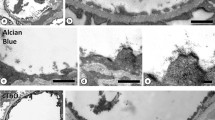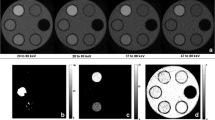Summary
In electron microscopy Thorotrast has been used as a specific contrasting agent for acid glycosaminoglycans. Because of its high atomic number, thorium (Z=90) gives good contrast in the electron microscope, but at present it is less frequently used for this purpose. We prepared a positive colloidal solution of ThO2 without stabilizers to compare its properties with those of ruthenium red and positive colloidal iron for contrasting fetal mouse epiphyseal cartilage. The results indicate that colloidal ThO2, which is easy to prepare in any laboratory, gives better results than ruthenium red and colloidal iron do in this kind of cartilage. Furthermore, as judged from data in the literature and obtained in our laboratory, it penetrates this tissue better than Thorotrast does, probably because of the absence of stabilizers.
Similar content being viewed by others
References
LaClaire JW, Dawes CJ (1975) An ultrastructural and histochemical localization of sulfated polysaccharides in Euchema nudum. J. Agardh. J. Phycol 11 (S):8
Cooper GW, Miller LH (1974) Propanoic acid-ferric oxide hydrosol. Differential cell surface binding and its relation to membrane lipid. J Histochem Cytochem 22:856–867
Curran RC, Clark AE, Lovell D (1965) Acid mucopolysaccharides in electron microscopy. The use of the colloidal iron method. J Anat 99:427–434
Eisenstein R, Sorgente N, Kuettner KE (1971) Organization of extracellular matrix in epiphyseal growth plate. Am J Pathol 65:515–534
Emeis JJ, Wisse E (1971) Electron microscopic cytochemistry of the cell coat of Kupffer cells in rat liver. In: Luzio NR di (ed) RES and immunephenomena. Plenum Press, London, pp 1–12
Geyer G (1973) Ultrahistochemie. Gustav Fischer, Stuttgart
Gustavson GT, Pihl E (1976) Staining of mast cell acid glycosaminoglycans in ultrathin sections by Ruthenium Red. Nature 216:697–698
Luft JH (1971) Ruthenium red and violet. II. Animal tissues. Anat Rec 171:369–415
McCracken MD, Barcellona WJ (1976) Electron histochemistry and ultrastructural localization of carbohydrate containing substances in the sheath of Volvox. J Histochem Cytochem 24:668–673
Matukas VJ, Panner BI, Orbison JL (1967) Studies on ultrastructural identification and distribution of protein-polysaccharide in cartilage matrix. J Cell Biol 32:365–377
Mowry RW (1963) The special value of methods that colour both acidic and vicinal hydroxyl groups in the histochemical study of mucins. With revised directions for the colloidal iron stain, the use of alcian blue 8GX and their combinations with the periodic acid-Schiff reaction. NY Acad Sci 106:402–423
Müller A (1906) Bemerkungen über das Hydrosols des Thoriumoxydhydrats. Ber Dtsch Chem Ges 93:2857–2859
Pease DC (1964) Histological techniques for electron microscopy. Academic Press, New York London
Pihl E, Gustavson GT, Falkmer S (1968) Ultrastructural demonstration of cartilage acid glycosaminoglycans. Histochem J 1:26–35
Reid PE, Culling FA, Dunn WL (1974) The histochemical interpretation of the complex results of methylation upon gastrointestinal tract mucins, with special reference to the periodic acid-Schiff reactivity. J Histochem Cytochem 22:986–991
Revel J-P (1968) A stain for ultrastructural localization of acid mucopolysaccharides. J Microsc 3:535–544
Scherft JP (1968) The ultrastructure of the organic matrix of calcified cartilage and bone in embryonic mouse radii. J Ultrastruct Res 23:333–343
Science Citation Index. Institute for Scientific Informations Philadelphia, Pennsylvania 19104, USA
Sorvari TE, Stoward RJ (1970a) Some investigations of the mechanisms of the so called “methylation” reactions used in mucosubstance histochemistry. I. “Methylation” with methyliodide, diazomethane and various organic solvents containing either HCl or thionylchloride. Histochemie 24:106–113
Sorvari TE, Stoward RJ (1970b) Some investigations of the mechanism of the so called “methylation” reactions used in mucosubstance histochemistry. II. Histochemical differentiation of lactone and ester groups in “methylated” mucosaccharides. Histochemie 24:114–119
Sorvari TE, Stoward RJ (1971) Saponification of methylated mucosubstances at low temperatures. Stain Technol 46:49–52
Spicer SS, Lillie RD (1959) Saponification as a means of selectively reversing the methylation blockade of tissue basophilia. J Histochem Cytochem 7:123–125
Te Velde J (1978) Methacrylate embedding in haematohistopathology. Thesis, University of Leiden
Verhaak RLOM (1958) Nierafwijkingen na pyelografie met Thorotrast. Thesis, University of Utrecht
Vilter V (1968) Contribution à l'étude du méchanisme de la “methylation-saponification” dans l-histochimie des mucines acides. Ann Histochim 13:205–220
Author information
Authors and Affiliations
Rights and permissions
About this article
Cite this article
Groot, C.G. Positive colloidal thorium dioxide as an electron microscopical contrasting agent for glycosaminoglycans, compared with ruthenium red and positive colloidal iron. Histochemistry 71, 617–627 (1981). https://doi.org/10.1007/BF00508387
Received:
Issue Date:
DOI: https://doi.org/10.1007/BF00508387




